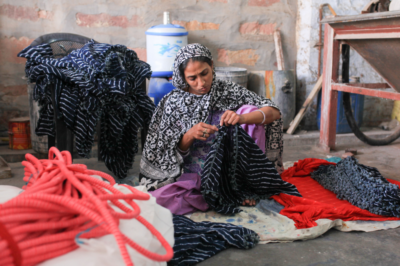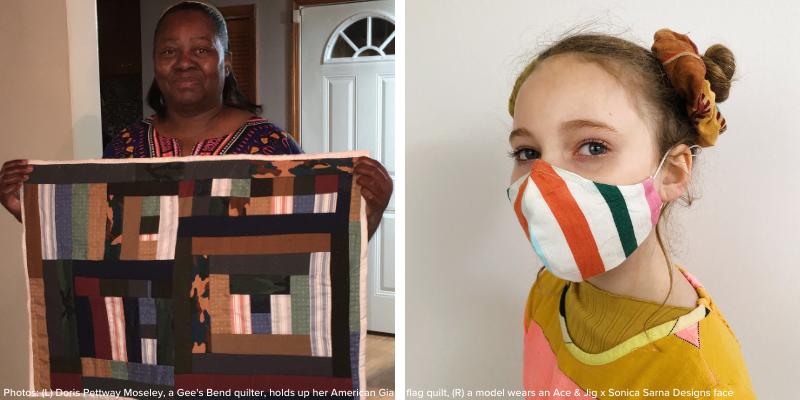Nest Fosters Upcycling in Artisan and Fashion Production

Featured Photo: An artisan patches together upcycled textiles in India (Credit: Sara Otto)
In November, Vogue predicted that upcycling would be the biggest trend of Spring and Summer 2021. By all accounts, that prediction appears to be holding true as brands from up-and-coming designers to established fashion houses are using upcycled materials on the runways and in their latest collections.
The fashion industry is well known to be one of the world’s largest polluters, and carbon emission tied to overproduction is, perhaps, the primary contributor. In recent years, luxury brands were revealed to be destroying excess product to manipulate scarcity and preserve their market value. This discovery renewed calls among critics and activists to address this issue throughout the industry, from high fashion to fast fashion.
While the trend of upcycling may be new to high fashion, it has been a staple of artisan production. For generations, the artisan sector has been incorporating upcycled materials into their products. Take, for example, the Quilters of Gee’s Bend, Alabama. The community is renowned for its unique quilting tradition which is borne out of its roots among the slaves of the Pettway Plantation. The ancestors of today’s quilters used remnants from seed bags and worn work clothes to patch together quilts to keep their families warm in the winter months.
Many of today’s quilters continue this tradition by combining upcycled materials with new textiles in their pieces. In 2020, Nest brokered a collaboration between several quilters and American Giant, a San Francisco-based clothing company, to use remnant fabric to design quilted interpretations of the American flag. These one-of-a-kind quilts were auctioned off among interested buyers as celebrations of this distinct American craft heritage. The proceeds from the sales were returned to their respective quilter.
Another example of Nest Artisan Guild members inspiring upcycled designs are the face coverings produced by Ace & Jig, a well-known slow fashion company, using deadstock textiles from Sonica Sarna Designs. Nest fostered this collaboration to bring fashionable, ethically-made face coverings to consumers during the Covid-19 pandemic. And, Nest has worked with Madewell to conceive creative solutions to ensure that overstock fabric in the fashion industry does not contribute to the systemic issue of industrial textile waste.

While the industry pivots toward sustainability, innovative solutions beyond upcycled designs are emerging to combat its environmental impacts. In addition to supporting upcycling collaborations, Nest is launching a more scalable solution with Queen of Raw, a digital platform for buying and selling deadstock fabric. In response to the vast amounts of excess fabric reported to be sitting in warehouses around the world (worth more than $120 billion USD), the founders launched an online marketplace where brands can offload these materials and anyone from makers to small brands can purchase them at a reduced price. The intent is to prevent these textiles from being burned, buried, shredded or otherwise destroyed by enabling them to be upcycled into other products.
Nest is partnering with Queen of Raw to provide our designer and brand partners with an easy way to discard excess materials that can be upcycled into new products by our Artisan Guild members. Guild members will be able to “shop” products and textiles supplied by Nest’s brand partners on Queen of Raw free-of-charge on the platform without brokering a formal collaboration.
For many artisans, upcycling is not necessarily a conscious effort to reduce their environmental footprints, but rather simply a practical method of production. Upcycling enables artisans to reduce materials costs by repurposing discarded remnants or purchasing discounted deadstock textiles. Yet, in spite of working with limited amounts or types of a material, they create beautiful, handcraft pieces. The fashion industry’s privilege requires that they consider their environmental impact, and use creative means–like upcycling–to address it. As they do, they should seek inspiration in the unique work of artisan communities who have been doing so for generations.
Once considered taboo in luxury design, many hope that this trend toward upcycling becomes standard practice within the industry. Repurposing deadstock materials is both a step forward in minimizing the environmental impact of overproduction and it can also be a way to pay homage to a brand or culture’s heritage through distinct textiles and materials. Nest echoes the sentiment of critics and activists who hope that upcycling is not just a seasonal trend but a new standard in fashion design and production. It will require a patchwork of efforts and solutions throughout the industry to reverse its environmental footprint, and upcycling is guaranteed to be one of those pieces.
To learn more about how Nest can support you with an upcycling collaboration, email Kendal Stone, Nest’s Brand Partnerships Manager, at [email protected].